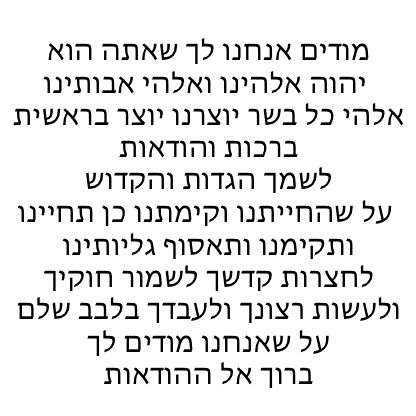|
|
 |
Modim d'Rabbanan
 What is Modim Derabanan?
What is Modim Derabanan?
During the shliach tzibur's repetition of the silent
shemoneh esrei we find an interesting phenomenon, we listen attentively
to the repetition and answer amen to all the brachot except for modim.
When the shliach tzibur recites the bracha of modim, we, the
congregation, recite our own modim quietly at the same time. This is
called "modim derabanan"or "the thanksgiving of the rabbis." What is
the purpose of the congregation reciting modim derabanan and why is it
called by this name?
Modim derabanan arose out of a simple, practical
need. In the time before written siddurim, many common people did not
know the tefillot by heart. In order to help these people fulfill their
obligation to pray, it was established that the shliach tzibur or
chazzan should recite out loud the shemoneh esrei that the congregation
had just prayed silently. These people would listen attentively,
answer amen and, hence, fulfill their obligation. In this way, the
shliach tzibur, translated literally as "the messenger of the
congregation," acted as an actual agent of the people.
This arrangement worked for all of the blessings
except for modim. Each
of the other eighteen blessings are tefillot or prayers beseeching God
for particular needs. As such, an agent or emissary can recite them for
the congregation that need only concentrate on the words and answer
"amen" for it to fulfill its obligation. Modim however, is different in
that it is a prayer of thanksgiving. In the words of the Avudraham, a
rishon who lived in the late 13th century, just as a servant cannot
praise his master through an emissary or messenger, so too, each member
of the congregation is obligated to personally praise, thank and accept
upon themselves God's kingship. To do this through an emissary would
not be proper.
It's interesting to note that the tefila we say in
modim derabanan is different than the one we say in the silent shemoneh
esrei. The Ri Migash, the rebbe of the Rambam, explains that this is to
specifically add additional words of gratitude and praise to our
Creator who has kept us alive and given us everything that we have.
As we have mentioned many times before, almost all of our tefillot were
composed prophetically by the Anshei Kenesset HaGedolah, the Men of the
Great Assembly, during the period after the destruction of the first
Beit Hamikdash. Modim derabanan is an exception. It was composed
by the rabbis of the Gemara many generations later. In fact, there were
four different Amoraim who disagreed as to what the exact text should
be. In the end, we incorporate all four of these texts into the prayer
that we actually say today. This gives this tefila its name, modim
derabanan, the modim of the rabbis.
Hopefully, this brief
explanation of the modim derabanan has given us a new insight into this
little discussed prayer as well as a heightened awareness of the
obligations and responsibilities we all have to our Creator.
Rabbi Eliezer Kessler
Houston, Texas
|
